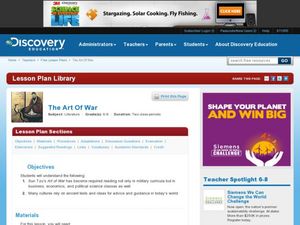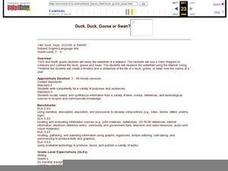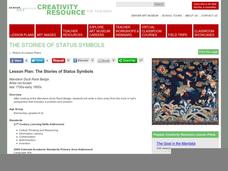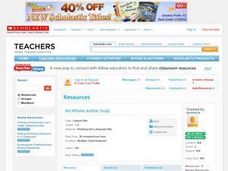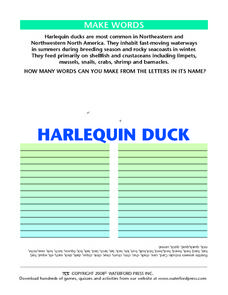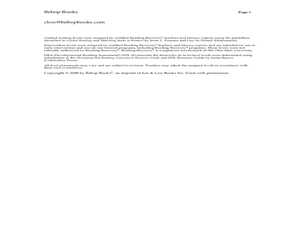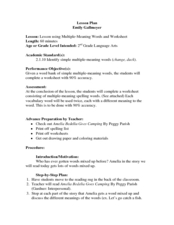Curated OER
Origami Ducks: Geometry, Listening, and Following Directions
Make origami ducks with your class to reinforce geometry concepts and vocabulary; develop fine motor and visual translation skills; and enrich study of Japanese culture, the pond habitat, or migration. Create a whole group "worksheet"...
Curated OER
Art: Drawing Ducks in Their Natural Habitats
Sixth graders explore various waterfowl species and discover how duck stamps are used. After researching specific types of birds for a stamp competition, they draw the birds in various natural settings. Before sending the submissions,...
Curated OER
The Art Of War
Students analyze the military, business, and political implications of Sun Tzu's book The Art of War. For this literature lesson, students read and discuss the novel prior to interviewing business people about business practices that...
Curated OER
Duck, Duck, Goose or Swan?
Students study the waterfowl of a wetland. They use Venn diagram to compare and contrast the duck, goose and swan. They research the waterfowl using the Internet. They create a timeline and slideshow of the life of a duck, goose, or swan...
Curated OER
The Stories of Status Symbols
A good writer needs to be observant and have an imagination. Hone those creative writing skills with an activity inspired by a very old Chinese artifact. Learners examine the piece Mandarin Duck Rank Badge, and then write a story from...
Curated OER
What a Character! Comparing Literary Adaptations
What do Robert Downey Jr., Basil Rathbone, Jeremy Brett, Fritz Weaver, Roger Moore, Benedict Cumberbatch, and Daffy Duck have in common? Why, it’s elementary, my dear Watson! They all have portrayed Sherlock Holmes. Literary detectives...
Curated OER
Mo Willems Author Study
Who is Mo Willems? Explore the author with your class. Learners read books written by Willems, compare and contrast the characters therein, and make predictions about what will happen. Finish off this author study by having small groups...
Curated OER
Quick, Quack, Quick Went The Duck
Students practice recognizing the phonemes and diagraphs in letters that blend together to form the "ck" sound. They interact with the book, "Quick, Quack, Quick!" by Marsha Arnold and the phrase, "Jack the duck found an icky sticky...
Curated OER
Duck for President
Second graders listen carefully to the story, "Duck for President" and then write and illustrate a new ending to the story; focusing on spelling sight words correctly and use complete sentences. They also work on forming letters...
Curated OER
Introduce Vocabulary: Giggle, Giggle, Quack (Cronin)
Farmer Brown has his hands full with a tricky duck in Norah Cronin's book Giggle, Giggle, Quack, the context of this vocabulary study. This text is available on YouTube if you can't find it. Before reading, introduce the high level...
Curated OER
BECOME A LOGOPHILE
It's time to write! First, lead your emerging writers in a power writing activity. It takes six minutes and focuses on creative brainstorming. The class is given two words (duck and apple are suggested, but alter the words for different...
Curated OER
Duckling Parade
Students create a diorama depicting scenes from "Make Way for Ducklings!" by Robert McCloskey. They illustrate their favorite scene from the book in a diorama as they discover what mallard ducks look like, their habitats, and how they...
Curated OER
Make Words: Harlequin Duck
In this science and language arts worksheet, students look at a picture of a harlequin duck and read a factual paragraph. Students then make as many words as they can from the letters in "Harlequin duck."
Curated OER
We Like to Read with Enthusiasm
Learners develop skills to become independent readers by telling a story with expression and enthusiasm. They read with expression and enthusiasm with a partner the books, "Duck on a Bike," and "David Goes to School," both by David Shannon.
Curated OER
Second Grade Language
In his language arts worksheet, 2nd graders answer multiple choice questions about subjects, verbs, kinds of sentences, and more. Students answer 25 questions.
Curated OER
What Do You See at the Pond?
With What Do You See at the Pond?, young readers explore pond life and practice reading strategies. Learners first make predictions and then read the simple story independently. After a second read-through with a partner, kids come...
Florida Center for Reading Research
Phoneme Split and Say
Little ones are provided with all the tools needed to begin segmenting phonemes. There are twenty Elkonin box picture cards, five blank Elkonin box cards, and full instructions on how to help pre-readers practice splitting and saying...
Curated OER
Symbols and Trading Cards
A silk rank badge was a symbolic emblem worn by high officials during the Qing Dynasty. Your class will get a chance to examine the details, symbolism, color, and design of such a badge as they make their own symbolic trading cards....
Curated OER
Dawdle Duckling
Students read the book Dawdle Duckling and complete different activities about the book. Students research the wetlands, research ducks, complete an oil and water experiment, map a cove, and more.
Curated OER
Color Me: Waterfowl
For this science and art worksheet, students examine a colored picture of a waterfowl. Students then color the black outline drawing with realistic colors. There are 4 birds to color: blue-winged teal, green-winged teal, harlequin duck...
Curated OER
Why Not Fabric?
Students investigate art from Native American culture by creating fabric. In this native art analysis lesson, students identify the art of Plains Indians and discuss how it is represented in their fabrics, beads and decorations. Students...
Curated OER
Remembering Chuck Jones
Students investigate the art of animation and various cartoon characters created by Chuck Jones. They complete a Webquest, watch video clips, draw a cartoon character, answer discussion questions, and create an original caricature of a...
Curated OER
Using Multiple Meaning Words
Second graders explore multiple meaning words. In this language arts lesson, 2nd graders read "Amelia Bedelia Goes Camping." Students discuss the different meanings of the words in the story. Students complete a worksheet.
ESL Kid Stuff
Places & Where We Live
Where does a cow live? Language learners engage in a series of activities that asks them to match animals with their habitats.


